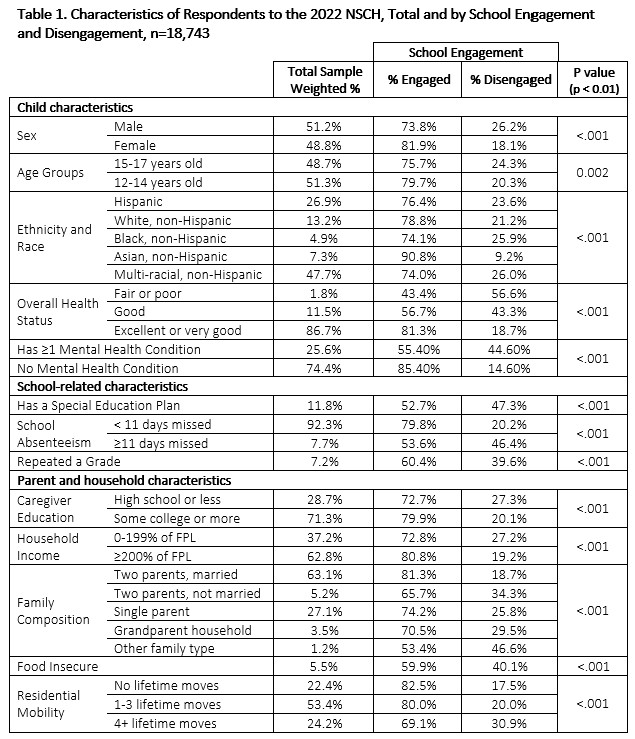Developmental and Behavioral Pediatrics 4: ADHD
Session: Developmental and Behavioral Pediatrics 4: ADHD
794 - Does School Disengagement Differ by Sex and Age Group among Adolescents?
Saturday, April 26, 2025
2:30pm - 4:45pm HST
Publication Number: 794.4868
Fiorella B. Castillo, The Children's Hospital at Montefiore, Lynbrook, NY, United States; Elisa Muniz, The Children's Hospital at Montefiore, New York, NY, United States; Ellen J. Silver, Albert Einstein College of Medicine, Newberg, OR, United States; Blanche Benenson, The Children's Hospital at Montefiore, Bronx, NY, United States; Maria Valicenti-McDermott, Albert Einstein College of Medicine, Bronx, NY, United States; Ruth EK. Stein, Albert Einstein College of Medicine, Larchmont, NY, United States

Fiorella B. Castillo, MD, MSPH, FAAP (she/her/hers)
Fellow
The Children's Hospital at Montefiore
Lynbrook, New York, United States
Presenting Author(s)
Background: School engagement is a complex measure of student involvement that combines behavioral, emotional, and cognitive aspects. School disengagement (SD) is linked to mental health challenges and poorer educational and behavioral outcomes. Few studies have examined sex and age differences in SD, but studies assessing lack of motivation, absenteeism and lack of persistence in schoolwork have had inconclusive findings. Therefore, further investigation is warranted to explore the association of SD with age and sex.
Objective: To explore differences in SD among US adolescents by sex and age group, and to identify correlates of SD in a large, representative sample of US adolescents 12-17 years old.
Design/Methods: We analyzed cross-sectional National Survey of Children's Health (NSCH) data from 2022 (N=18,743). We used an NSCH-developed measure of SD created from parent responses to two questions: caring about doing well in school and doing required homework. SD was divided into Engaged and Disengaged. We adjusted for complex sampling and calculated weighted prevalence estimates for all variables. Chi-square and logistic regression were used to assess the relationships between SD, sex and age group (12-14 and 15-17 year olds). while controlling for key clinical, school-related, and demographic variables (p < 0.01). An interaction term was introduced to assess whether there is a combined effect of age group and sex on the probability of SD.
Results: The cohort was 51.2% male and 48.7% were 15–17-year-old. 25.6% had at least 1 mental health condition (MHC), 11.8% had a special education plan (SEP), 7.7% missed ≥11 school days, 7.2% repeated a grade. SD was observed in 26.2% of males vs. 18.1% of females (p < 0.001), in 24.3% of 15-17yo, and 20.3% of 12-14yo (p=0.002) (Table 1). Significantly greater odds of SD were observed in males (aOR: 1.832, 99%CI: 1.455-2.307) vs. females. Additionally, there was no combined effect of age subgroup and sex on the probability of SD (sex*age group aOR: 1.316, 99%CI: 0.831-2.083). Greater odds of SD were also observed in adolescents with ≥1 MHC, ≤ very good health, who have a SEP, who missed ≥11 school days and in households with two not married parents (Table 2).
Conclusion(s): Greater odds of SD were observed in male compared to female adolescents. Age group was only significant in the bivariate analysis. Moreover, several family, health and school factors were associated with SD.
Table 1. Characteristics of Respondents to the 2022 NSCH, Total and by School Engagement and Disengagement, n=18,743

Table 2. Logistic Regression of School Disengagement Among US Adolescents 12 -17 years old, NSCH 2022
.jpg)

